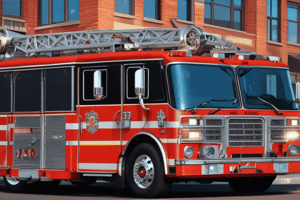Podcast
Questions and Answers
What is the purpose of the Operating Instruction mentioned in the text?
What is the purpose of the Operating Instruction mentioned in the text?
The purpose of the Operating Instruction is to provide a standardized approach to Fire Incident Command, control, and coordination of emergency response providing a common hierarchy within which responders from multiple agencies can be effective, managing incidents.
How does the instruction define Command within structures during any stages of the incident?
How does the instruction define Command within structures during any stages of the incident?
The instruction provides the Fire Commander with a clear framework to structure, organise, and manage emergencies effectively, defining Command within structures during any stages of the incident (initial, expanding and contracting).
What is the responsibility of the Fire Commander according to the text?
What is the responsibility of the Fire Commander according to the text?
The Fire Commander is responsible for the overall management of QatarEnergy F&R resources on-site during an incident.
What response organization should align with the QatarEnergy Incident Management System according to the text?
What response organization should align with the QatarEnergy Incident Management System according to the text?
Explain the priorities of the incident command in a fire incident.
Explain the priorities of the incident command in a fire incident.
What are the primary responsibilities of the Fire Commander at the scene?
What are the primary responsibilities of the Fire Commander at the scene?
Who assumes command at the scene of a fire incident?
Who assumes command at the scene of a fire incident?
What is the primary duty of the Fire Commander?
What is the primary duty of the Fire Commander?
Explain the difference between incident action plans for small to medium-sized incidents and complex incidents.
Explain the difference between incident action plans for small to medium-sized incidents and complex incidents.
What is the responsibility of the Fire Commander in relation to IMS-201 for small incidents?
What is the responsibility of the Fire Commander in relation to IMS-201 for small incidents?
What triggers the transfer of command, and what is its purpose?
What triggers the transfer of command, and what is its purpose?
When is the activation of IMT/IST considered, and what does it signify for the incident?
When is the activation of IMT/IST considered, and what does it signify for the incident?
What are the five points of the size-up system for a Fire Commander?
What are the five points of the size-up system for a Fire Commander?
When should the Fire Commander prioritize establishing a Forward Command Post (FCP)?
When should the Fire Commander prioritize establishing a Forward Command Post (FCP)?
Under what circumstances may the Fire Commander declare Investigative Mode or Fast Attack Mode?
Under what circumstances may the Fire Commander declare Investigative Mode or Fast Attack Mode?
What is an Incident Action Plan (IAP)?
What is an Incident Action Plan (IAP)?
Explain the significance of the transfer of command occurring only to an officer on the scene in the event of a fire incident.
Explain the significance of the transfer of command occurring only to an officer on the scene in the event of a fire incident.
What is Unified Command and how does it function in managing incidents with multiple jurisdictions or organizations?
What is Unified Command and how does it function in managing incidents with multiple jurisdictions or organizations?
What are the primary players in the Fire Command Team and why are they crucial in handling dynamic and intense incident scenes?
What are the primary players in the Fire Command Team and why are they crucial in handling dynamic and intense incident scenes?
What is the preferred method for regulating the transfer of command and why?
What is the preferred method for regulating the transfer of command and why?
Flashcards are hidden until you start studying
Study Notes
Fire Incident Command Structure and Procedures
- In the event of an incident, the transfer of command should not occur to an officer who is not on the scene, to prevent compromising incident management.
- The actual transfer of command is regulated by a specific procedure, involving communication between the officer assuming command and the person being relieved.
- The arrival of a more senior officer at the incident scene does not automatically transfer command; it only transfers when the process has been completed.
- A more senior officer may elect to have a subordinate continue the role of Fire Commander, depending on the situation and progress of the incident.
- When responding to incidents with multiple jurisdictions or organizations, Unified Command can be applied to manage the response under an integrated command structure with aligned objectives.
- Under Unified Command, each member is responsible for keeping other members informed, and there is no single "commander."
- The organizational structure of the Fire Incident Command includes distinct titles for each element, such as Branch Director, On-Scene Commander, Fire Commander, Division and Group Commander, Sector Commander, and others.
- A Fire Command Team, comprising the Fire Commander, Support Officer, and Safety Officer, is an organizational response to rapidly bring a significant incident under control.
- The primary players in the Fire Command Team are crucial for providing enough command and control to handle dynamic and intense incident scenes.
- The Station Commander should assume command of the incident by virtue of rank and seniority when arriving at the scene at the same time as the 1st Alarm assignment.
- The transfer of command should be regulated by a specific procedure, with face-to-face communication being the preferred method.
- The more senior Officer must determine if the Fire Commander is completely aware of the position and function of operating appliances and the general situational status.
Studying That Suits You
Use AI to generate personalized quizzes and flashcards to suit your learning preferences.



